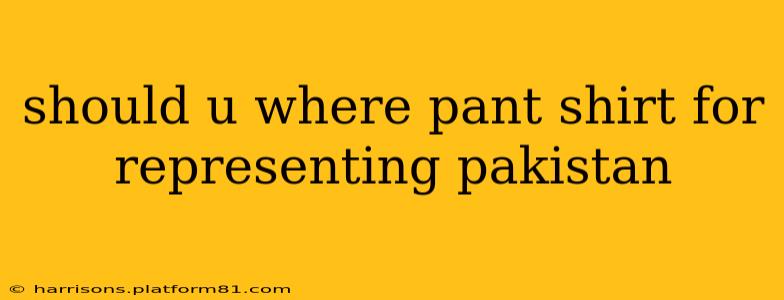Should You Wear a Shalwar Kameez to Represent Pakistan?
The question of what to wear when representing Pakistan is a nuanced one, touching upon cultural pride, personal expression, and the context of the representation itself. There's no single "right" answer, as appropriateness depends heavily on the specific situation.
While the shalwar kameez is a beautiful and widely recognized traditional garment of Pakistan, its suitability for representing the country isn't universally applicable. Let's delve into various scenarios and consider the factors that influence the choice of attire.
What are the different contexts for representing Pakistan?
The appropriateness of wearing a shalwar kameez depends largely on the setting. Here are a few examples:
-
Formal Government Events: In formal diplomatic settings or official government functions, a more formal suit might be deemed appropriate. This ensures a professional and respectful presentation in line with international diplomatic norms. While a shalwar kameez might be acceptable in some less formal government events, it is always best to err on the side of caution and check the dress code beforehand.
-
Cultural Events and Festivals: At cultural events celebrating Pakistani heritage, such as a mela or a national holiday celebration, wearing a shalwar kameez is not only appropriate but highly encouraged. It's a powerful way to showcase national pride and cultural identity.
-
Sporting Events: The choice of attire at sporting events is less strictly defined. While some athletes might opt for a shalwar kameez during pre-game or post-game presentations, the practical considerations of sporting activities usually dictate more functional sportswear.
-
International Conferences and Business Meetings: In professional contexts like international conferences or business meetings, attire should reflect the expectations of the setting. A suit or business formal wear might be the most appropriate choice to make a professional impression.
-
Informal Gatherings: In informal social gatherings, the choice of clothing is far less restrictive. A shalwar kameez, western attire, or a fusion of both can all be perfectly acceptable depending on your comfort level and the atmosphere of the event.
Is it mandatory to wear a shalwar kameez to represent Pakistan?
No, wearing a shalwar kameez is not mandatory to represent Pakistan. While it's a strong symbol of national identity, your representation goes far beyond your clothing. Your actions, words, and behaviour are far more impactful in reflecting Pakistan’s image than any specific item of clothing. Representing Pakistan involves demonstrating positive values, skills, and characteristics that showcase the country in a positive light.
What if I'm not comfortable wearing a shalwar kameez?
Your comfort is important. If you feel uncomfortable or out of place wearing a shalwar kameez, it's perfectly acceptable to wear clothing that you feel confident and presentable in. Representing your country effectively hinges more on your conduct and actions than your attire. Choose attire that allows you to feel comfortable and confident, so you can fully focus on the task at hand.
How can I represent Pakistan in other ways?
Representing Pakistan is about more than just clothing. You can represent your country through:
- Positive conduct: Be respectful, kind, and uphold good values.
- Academic achievements: Excel in your field and bring pride to Pakistan through your accomplishments.
- Community involvement: Contribute positively to your local community and support Pakistani initiatives.
- Promoting Pakistani culture: Share your country's rich heritage, traditions, and arts with others.
Ultimately, the best way to represent Pakistan is by being a positive ambassador for the country, regardless of what you choose to wear.
